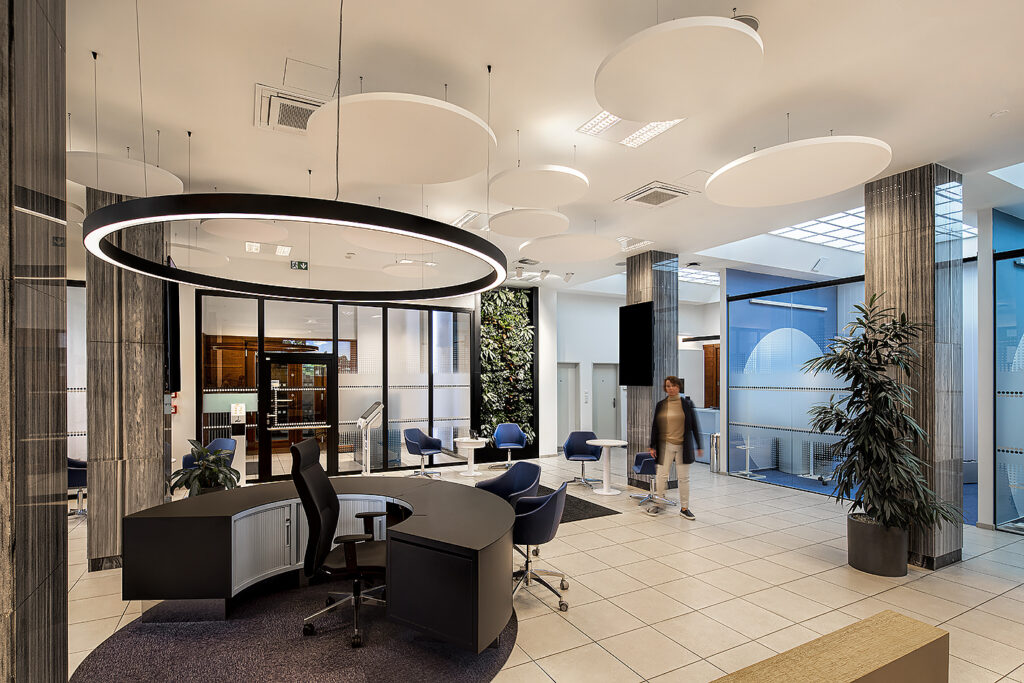
Excessive noise levels can be a significant distraction while trying to talk to a client, and it can make it difficult to hear and understand what the other person is saying. It can also be frustrating and stressful for both the client and the bank employee.
In addition to being a distraction, excessive noise level also creates a negative impression on the clients, making them feel that the bank is not professional or serious about providing quality service. Therefore, it is essential to minimize noise levels in bank halls and create a comfortable, quiet environment that enables clear communication and fosters positive interactions between the bank employee and the client.
Counters vs. digital banking
Banknotes and coin counters are a significant source of noise on bank premises. These machines are designed to count and sort large amounts of currency quickly, which results in loud, repetitive noise levels that become disruptive to bank employees and clients.
To minimize the impact of banknote and coin counters on acoustic comfort in banks, it is smart to locate the counters in a separate room or enclosed space with soundproofing materials. This can help to contain the noise within a specific area and prevent it from spreading to other parts of the bank.
While digital banking is becoming increasingly popular, there is still a significant demand for cash transactions in the bank sector – especially at this bank branch.
Layout of the space
The bank hall is an open space including a workstation where clients receive general information, then 2 workstations where face-to-face customer service is provided, and finally a workstation where is the coin and banknote counter machine located. There are other 2 semi-open meeting rooms. As you can feel it is a multi-functional space. It has an area about 100m2 with a height of 3,5m.
There are additional 3 separate meeting rooms and non-public rooms dedicated only to employees showed in the floor plan below.

The bank employees were bothered by the insufficient level of privacy during negotiations and by a high level of noise, especially when the banknote and coin counter was used. The machine is placed directly in the bank hall (see the floor plan above) and the space became unbearable to communicate while using the machines.
Materials and surfaces play a key role
The bank branch is situated in an older historical building. The interior has been renovated recently. There are used only reflective surfaces such as plasterboard ceiling panels, glass partitions, wooden claddings, and tiles on the floor. Part of the space has also glass ceiling skylights.
The space gives a very pleasant impression until the counter is on or until you hear an intimate conversation between a bank employee and a client from the other side of the room. Focus on design and visual aesthetics is obvious as well as the acoustic issues in the space.


Why additional acoustic treatment may not be optimal?
The renovated premise had been in operation for more than 1 year. Increasing staff complaints made the investor tackle the poor acoustics. Retrofitting the space with acoustic treatments was challenging. The acoustic design was limited by existing installations, technical elements in the ceiling an,d wall graphics in the hall.
The only acceptable solution in the bank hall was to install free-hanging units on the ceiling but in a limited quantity. Further, necessary adjustments included wall treatments at the banknote and coin machine workstation, then in the semi-open meeting rooms. Just reminds us that the ceiling is made of glass skylights in these rooms.
The measurements of reverberance were taken before and after the acoustic treatment. Original T values fluctuated over 1,2s, while the new environment approached values from 0,9s to 0,82s. The expected decrease of sound pressure level was calculated with results of -2,1dB. To be honest, the differences in reverberance and noise level are not so significant.

Acoustic measurements are important for objectively evaluating the acoustic properties of a space, but ultimately, the subjective experience of the people using the space is what matters most. The bank hall would deserve a more extensive acoustic intervention accompanied by construction works.
Comment
Person 1:“ Overall noise level is a little bit lower than it used to be. When I occupy the workstation by the wooden claddings and I communicate to a client, I can hardly perceive a difference.“
Commitment to sustainability
Acoustic comfort is an important aspect of sustainable indoor environments. Sustainable design seeks to create buildings that are not only environmentally friendly but also promote the well-being and comfort of occupants.
By promoting sustainable practices in bank operations and supporting sustainable businesses and projects at the same time, banks can demonstrate their commitment to sustainability, encourage positive environmental and social outcomes, and contribute to a more sustainable future for all.
For more information contact Iveta Kralova on [email protected]

